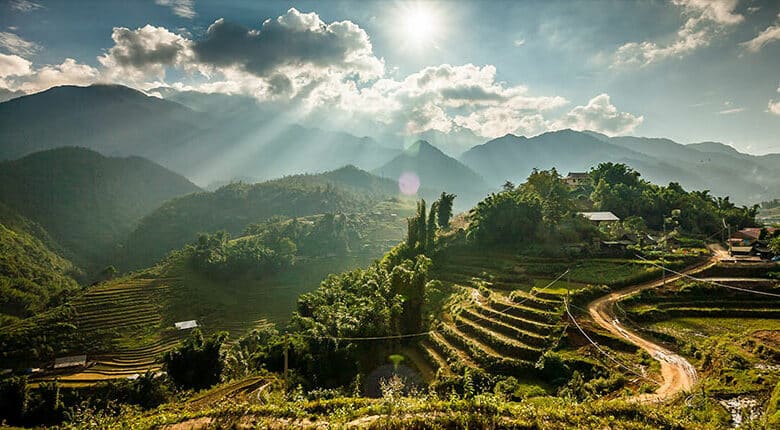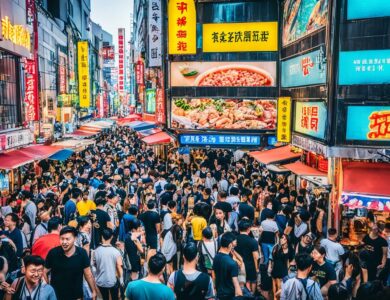
Sapa, located in the majestic mountains of Vietnam, is a hidden gem that offers breathtaking natural beauty, vibrant ethnic culture, and adventurous experiences. Nestled in the northwest region, this enchanting destination has become a popular choice for travelers seeking an off-the-beaten-path experience. In this article, we will delve into the wonders of Sapa, exploring its picturesque landscapes, diverse ethnic communities, traditional markets, and outdoor activities that make it a must-visit destination.
Discovering Sapa’s Spectacular Landscapes
Sapa boasts a mesmerizing landscape characterized by lush rice terraces, cascading waterfalls, and misty mountains. The region’s verdant valleys and undulating hills create a surreal scenery that has captivated travelers from around the world. Trekking through Sapa’s trails offers unparalleled vistas of the iconic rice terraces, where the golden hues of the fields contrast with the vibrant green surroundings.
Embracing the Cultural Diversity of Ethnic Communities
One of the most remarkable aspects of Sapa is its diverse range of ethnic communities. The region is home to several tribes, including the Hmong, Dao, Tay, and Giay, each with its distinct customs, traditions, and attire. Visitors have the opportunity to engage with these communities, learn about their fascinating heritage, and immerse themselves in their daily lives. Homestays with local families provide an authentic glimpse into their culture, offering a unique and enriching experience.
Exploring Sapa’s Traditional Markets
Sapa’s bustling markets are vibrant hubs of activity where locals gather to sell their produce, handicrafts, and textiles. The markets are a treasure trove of traditional clothing, intricately embroidered fabrics, and handmade souvenirs. The Bac Ha Market, held every Sunday, is renowned for its vast array of goods and provides a glimpse into the lives of the ethnic communities who come from far and wide to trade and socialize.
Engaging in Outdoor Adventures
For adventure enthusiasts, Sapa offers an array of thrilling activities. Trekking is the most popular adventure in the region, with numerous trails catering to different skill levels. From gentle strolls through villages to challenging hikes up Fansipan, the highest peak in Indochina, there are options for everyone. Other exciting activities include mountain biking, motorbike tours, and exploring the underground caves.
Unwinding in Tranquil Homestays
To truly immerse oneself in the local culture, staying in a homestay is highly recommended. Homestays in Sapa offer comfortable accommodation, warm hospitality, and an opportunity to experience the daily routines of the ethnic communities. Waking up to the stunning mountain views, enjoying home-cooked meals, and sharing stories with the host families createa sense of belonging and a deeper connection to the destination.
Savoring the Unique Gastronomy of Sapa
Sapa’s culinary scene is a delightful fusion of traditional Vietnamese flavors and the distinctive cuisine of the ethnic communities. Local delicacies such as “thang co” (horse meat soup), “bamboo-tube rice,” and “smoked buffalo meat” showcase the rich culinary heritage of the region. Exploring the local eateries and street stalls allows visitors to indulge in these unique dishes, tantalizing their taste buds with flavors they won’t find elsewhere.
Experiencing Festivals and Traditions
Sapa is known for its vibrant festivals and cultural celebrations. The Flower Hmong New Year, celebrated in late January or early February, is a grand spectacle of colorful costumes, traditional music, and lively dances. Visitors can witness the traditional rituals, join in the festivities, and gain a deeper understanding of the cultural significance behind these events. The Mid-Autumn Festival and the Love Market are also noteworthy experiences that showcase the local traditions and customs.
Understanding Sapa’s Rich History
Sapa has a fascinating history that spans centuries. Originally inhabited by indigenous tribes, the region later became a French hill station during the colonial era. The remnants of French architecture can still be seen in the town, adding a unique charm to the area. Exploring the Sapa Museum provides insight into the history, culture, and heritage of the ethnic communities, allowing visitors to grasp the historical context of the region.
Unveiling Alishan: The Perfect Destination for Nature Lovers
Supporting Sustainable Tourism Initiatives
Sustainable tourism is crucial in preserving the natural and cultural heritage of Sapa. Several organizations and initiatives are working towards responsible tourism practices, aiming to minimize the impact on the environment and support the local communities. Travelers can contribute to these efforts by choosing eco-friendly accommodations, supporting local businesses, and respecting the customs and traditions of the ethnic communities.
Best Time to Visit Sapa
The best time to visit Sapa is from March to May and from September to November. During these months, the weather is pleasant, and the landscapes are at their most vibrant. Spring brings blooming flowers, while autumn paints the hills with shades of gold and red. It is advisable to avoid the rainy season, which occurs from June to August, as the trails can become slippery and visibility may be reduced due to fog.
How to Get to Sapa
To reach Sapa, the most common way is to take an overnight train from Hanoi to Lao Cai. From Lao Cai, you can hire a taxi or take a local bus to Sapa town, which is approximately 38 kilometers away. Another option is to book a bus or private transfer directly from Hanoi to Sapa, which offers convenience and comfort for travel.
Where to Stay in Sapa
Sapa offers a range of accommodation options to suit different budgets and preferences. From luxury resorts with stunning mountain views to cozy guesthouses and homestays, there is something for everyone. Popular areas to stay include Sapa Town, Cat Cat Village, and Ta Van Village, where you can experience the authentic charm of the region.
Safety Tips for Traveling in Sapa
While Sapa is generally a safe destination, it is essential to take certain precautions to ensure a smooth and enjoyable trip. It is advisable to hike with a local guide who knows the trails well and can provide valuable insights. Packing appropriate clothing, including sturdy shoes and rain gear, is important, as the weather can change quickly in the mountains. Additionally, staying hydrated, applying sunscreen, and carrying a basic first aid kit are recommended.
Useful Phrases for Interacting with Locals
Interacting with the locals in Sapa can enhance your experience and create meaningful connections. Learning a few basic phrases in the local languagecan go a long way. Here are some useful phrases to help you communicate with the locals:
- Hello – Xin chào (sin chow)
- Thank you – Cám ơn (kahm uhn)
- How are you? – Bạn khỏe không? (bahn kweh khohng?)
- Yes – Vâng (vahng)
- No – Không (khohng)
- Please – Làm ơn (lam uhn)
- Excuse me – Xin lỗi (sin loy)
- I don’t understand – Tôi không hiểu (toy khohng hyoo)
- Can you help me? – Bạn có thể giúp tôi được không? (bahn koh thee yoop toy duc khohng?)
- Where is…? – …ở đâu? (…uh dow?)
Learning these phrases and using them during your interactions will show respect for the local culture and make your interactions more enjoyable.
Conclusion
Sapa, Vietnam, is a captivating destination that offers a unique blend of natural beauty, cultural diversity, and immersive experiences. From the breathtaking landscapes to the vibrant ethnic communities, every aspect of Sapa will leave you in awe. By exploring the region’s spectacular terraced fields, engaging with the local communities, and indulging in the flavors of Sapa’s cuisine, you’ll create memories that will last a lifetime. So pack your bags, embrace the wonders of Sapa, and embark on a journey that will enrich your soul.
FAQs
1. Is Sapa suitable for all types of travelers?
- Yes, Sapa caters to a wide range of travelers, from adventure enthusiasts to those seeking a cultural experience. There are various activities and accommodations available to suit different preferences.
2. Are there any specific customs or etiquette to keep in mind when visiting Sapa?
- Respecting the local customs and traditions is important in Sapa. It is advisable to dress modestly, especially when visiting ethnic villages, and always ask for permission before taking someone’s photograph.
3. Can I visit Sapa independently, or do I need a guide?
- While it is possible to explore Sapa independently, hiring a local guide can greatly enhance your experience. They can provide valuable insights, navigate the trails, and facilitate interactions with the local communities.
4. Are there any eco-friendly initiatives in Sapa?
- Yes, there are several sustainable tourism initiatives in Sapa that focus on preserving the environment and supporting the local communities. By choosing eco-friendly accommodations and engaging in responsible tourism practices, you can contribute to these initiatives.
5. What are some other attractions near Sapa that are worth visiting?
- Near Sapa, you can explore attractions such as the Silver Waterfall, the Love Waterfall, and the Muong Hoa Valley. These sites offer stunning natural beauty and opportunities for further exploration.



